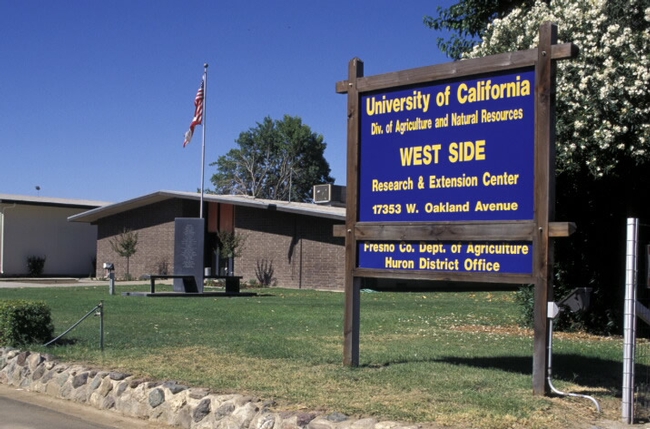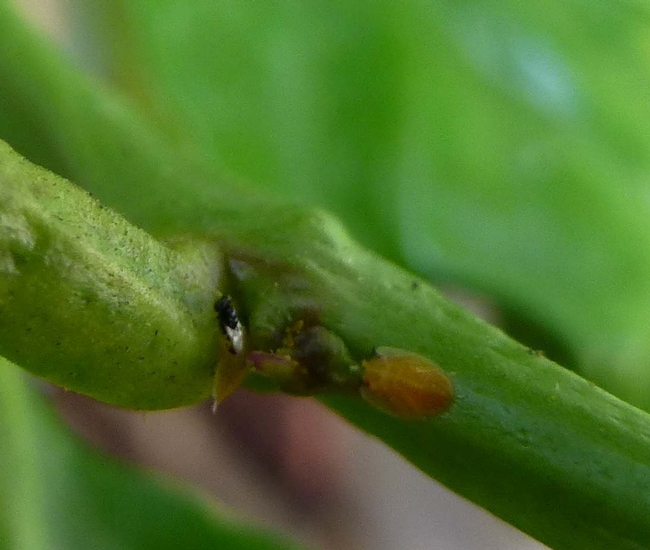Posts Tagged: Bruce Lampinen
May News Clips
City Visions: Tech and the future of smart, sustainable farming
(KALW), May 7, 2018
Host Ethan Elkind and guests explore the impact of new technologies on our agricultural industry.
What are the biggest challenges to our current food production system? And, how are Bay Area innovators meeting these challenges while promoting sustainability, efficiency and profitability?
Guests:
- Charles Baron, co-founder and vice-president of product at Farmer's Business Network.
- Jaleh Daie, Ph.D., founder and chair of AgriFood Tech and partner at Aurora Equity.
- Glenda Humiston, Ph.D., vice president of University of California's Division of Agriculture and Natural Resources.
http://kalw.org/post/city-visions-tech-and-future-smart-sustainable-farming#stream/0
Workshop planned on Napa fire prevention and best practices
(Napa Valley Register), May 7, 2018
A one-day seminar is planned for May 30 to look at the Napa ecosystem's recovery after the October wildfires and what policies are needed to reduce future fire impacts.
The workshop will be Wednesday, May 30, from 8 a.m. to 3:45 p.m. at Napa Valley College's Performing Arts Center, 2277 Napa Vallejo Highway.
Cost is $15 per person, with registration required at http://ucanr.edu/napafireworkshop2018. For more information, call 530-666-8143.
The program is sponsored by UC Cooperative Extension, Napa County Farm Bureau and the U.S. Department of Agriculture's Natural Resources Conservation Service.
Farming takes center stage at Yolo County Fairgrounds
(Woodland Daily Democrat) Cutter Hicks, May 4
Field trips to the fairgrounds led to a farming experience for students as the Yolo County 4-H and Farm Bureau hosted its 10th annual Farm Connection Day to kick off the Spring Show this weekend.
The four-hour event Friday featured more than 100 agricultural displays and hands-on activities for kids of all ages as nearly 2,500 visitors walked through the gates.
Farm Connection Day was open to the public and more than 200 4-H students teamed up to host the event — with a little help from adult volunteers. Their focus was to teach students of Yolo County the aspects of the organization before judging shows later that day.
DeAnn Tenhunfeld, a Farm Connection Day organizer, said that the attendance was the largest seen since she founded it in 2008.
http://www.dailydemocrat.com/business/20180504/farming-takes-center-stage-at-yolo-county-fairgrounds
Frost damage varied for California nut trees
(Farm Press) Robyn Rominger, May 2, 2018
Some almond growers experienced frost damage from recent freezing conditions, say University of California experts.
“There's really a lot of damage,” says Katherine Jarvis-Shean, UC Cooperative Extension orchard systems advisor for Sacramento, Solano, and Yolo counties. “The earlier varieties really took a hit. Some trees even dropped their nuts due to frost damage. It's pretty bad in some orchards.”
… Bruce Lampinen, UCCE almond and walnut specialist, measured temperatures in an almond trial at Davis, and notes that “Feb. 20 and 24 were the coldest days. It was very problematic because that's when the trees were in full bloom.” At full bloom, temperatures below 28 degrees F. can cause crop loss.
…Phoebe Gordon, UCCE orchard systems advisor for Madera and Merced counties, says, “From what I've seen and heard, the damage has been variable. Some orchards weren't hit that hard, and others were hit very hard. I think it depended a lot on micro-climate and what stage the trees were in. They become more susceptible to frost damage as they transition from dormant to full bloom, and to nut set. I don't think we'll really know until ‘June drop' is finished what the final load is.”
Dani Lightle, UCCE orchard systems advisor in Glenn and Butte counties, says, “Almonds were right in the middle of full bloom when the frost happened. Most of the orchards in my area seem to have escaped. We didn't seem to cross the threshold to where there was heavy damage. Of course, there are exceptions, but by and large we came out better in the end than we thought we would.”
New weapon in fight against walnut blight
(Farm Press) Robyn Rominger, May 2, 2018
Walnut growers have a new tool to help manage blight disease in their orchards — Kasumin 2L, manufactured by Arysta LifeScience, is the trade name for kasugamycin, and is available as part of a strategy to control the disease.
The new bactericide was discussed at a recent University of California Cooperative Extension breakfast meeting at Yuba City. “It's great to have another chemistry in the rotational loop for blight management in walnuts,” says Emily Symmes, UCCE integrated pest management advisor.
http://www.westernfarmpress.com/tree-nuts/new-weapon-fight-against-walnut-blight
Agriculture research not immune to drought
Fitchette opened his story with the plight of ag research at the UC West Side Research and Extension Center near Five Points. Many of the farmers in the area will receive no surface water allocation this year; neither will the research center.
The facility can pull water from a deep well, but it is not enough nor is the water quality adequate for all the farming operations, said Bob Hutmacher, UC Cooperative Extension specialist and center director. He said scientists at the station must cut back their water use this year by 25 percent.
“I can speak for myself: I have about a half dozen cotton projects and a sorghum project, along with a sesame project and a couple of other things I'm working on,” he said. “I'm downsizing most of them to the greatest degree I can and I'm going to cancel one of them.”
One trial that will not go forward at West Side is an almond variety trial. However, UC Cooperative Extension advisors in other areas are working with the Almond Board to keep the research underway. UCCE advisors Joe Connell will oversee the Chico State almond variety trial, Roger Duncan the Salida trial, and Gurreet Brar the Madera County trial.
The Western Farm Press Story included drought-related ag research news from myriad UCCE academics:
- Duncan said his work with fruit and nut crops has not been negatively impacted by the drought.
- David Doll, UCCE advisor in Merced County, said the increased reliance on groundwater has ruined several orchard nitrogen trials because the groundwater in northern Merced has high rates of nitrate nitrogen, which acts as a nitrogen fertilizer.
- Dan Munk, UCCE advisor in Fresno County, said he will continue putting off alfalfa trials at the WSREC “indefinitely until a more secure water supply is available.”
- Scott Stoddard, UCCE advisor in Merced County, reports positive and negative impacts from the drought. He won't do tomato research at West Side REC, but will continue work in sweet potatoes to determine how little water they need to produce a reasonable crop.
- Chris Greer, UCCE advisor in Sutter, Yuba, Colusa and Glenn counties, said some rangeland trials were impacted by the lack of rain.
- Bruce Lampinen, UCCE specialist in the Department of Plant Sciences at UC Davis, has seen his orchard trials in Arbuckle severely impacted by the drought.
Natural enemy of Asian citrus psyllid taking hold
Mark Hoddle, UC Cooperative Extension specialist in the Department of Entomology at UC Riverside, collected Tamarixia radiata in the Punjab region of Paskistan. After a period of quarantine, the beneficial insect was released in Southern California citrus trees beginning in December 2011.
The Press-Enterprise article said Hoddle has found three sites — two in Fontana, one in San Bernardino — where the wasp has attacked psyllid larvae, killing them.
“We’re trying to understand how big an impact this wasp is having on the Asian citrus psyllid,” Hoddle said. “It’s too early to make estimates, but (the finds are) encouraging.”
For more details on the establishment of Tamarixia, see the UC Riverside Center for Invasive Species Research blog.
Olive oil's heath benefits? It's a slippery question
Katherine Tallmadge, The Washington Post
Polyphenols are what make olive oil more healthful than other vegetable oils, like canola oil. However, when tested, polyphenols were surprisingly low in most commercially available olive oils, USDA-ARS researchers reported. They also don't live up to international or USDA quality standards, according to studies by the UC Davis Olive Center.
Studies show that, as days, weeks and months go by after harvest, the polyphenol content and health benefits of the oil diminish.
“Think of olive oil as olive juice with a maximum two-year shelf life,” says Selina Wang, research director at the Olive Center.
Covenant between almond growers and researchers
Bob Curtis and Gabriele Ludwig, The Almond Board, Western Farm Press
If managed well, commercial trials can provide benefits for growers, researchers and the industry at large, but they can pose challenges. Almond research plots are a covenant between the grower and researcher that requires both parties to communicate and understand the goal of the research.
Bruce Lampinen, UC Cooperative Extension specialist in the Department of Plant Sciences at UC Davis, says involving grower cooperators offers the research community the benefit of gathering commercial data to test promising practices or understand impacts in a real-world setting. Without this research, many of today's common practices that have led to dramatic increases in yield and improved quality, along with efficient and environmentally responsible orchard management, would not have been discovered.
2010 was an excellent year for almonds
California almonds harvested in 2010 are expected to amount to 1.65 billion pounds or more, according to an article by Associated Press reporter Jeff Nachtigal. The story was picked up by many national publications, including the New York Times and the CBS News website.
The sizable almond crop is being met with strong worldwide demand and relatively high prices.
"The nut crops in general are looking good in California," UC farm advisor emeritus John Edstrom was quoted in the story.
UC Davis Cooperative Extension almond specialist Bruce Lampinen told the reporter that improved agricultural techniques used by California's 6,000 almond growers - such as planting trees closer together, cutting back on pruning and knocking off "mummies" during the winter to control navel orangeworm - have helped boost production.
But, the almond industry is not without its challenges.
- UC Davis entomologist Eric Mussen told the reporter that farmers are still concerned about major honeybee die-offs, which have doubled the cost of renting bees for pollination in the past five years.
- Water shortages are also a concern for some producers, according to Almond Board chair Mike Mason.
California almond growers produce 100 percent of the U.S. crop, supplying 100 percent of the domestic market, and 80 percent of the world market, said an Western Farm Press article about the bumper almond crop.

Improved almond production techniques have helped grow the industry.



